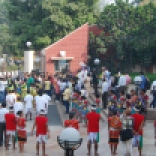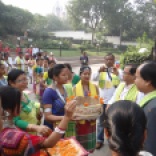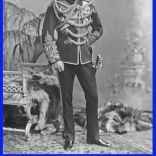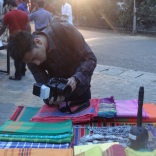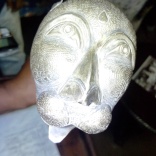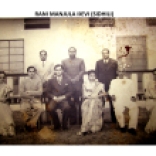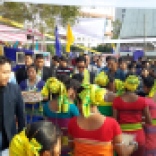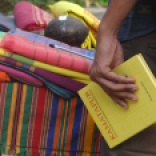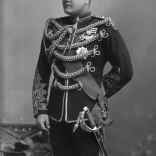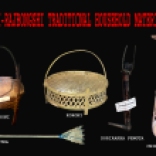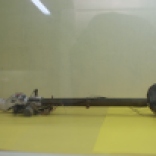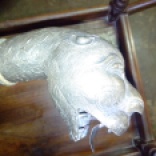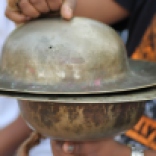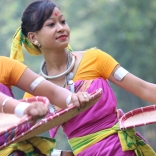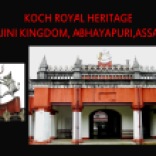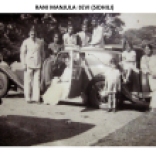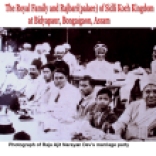
Goalini Nritya Goalini Nritya is the most popular form of folk dance among the people of western Assam basically warmed up by the Koch-Rajbongshis. This particular folk dance originated at a place Gauripur in Assam, the cultural centre of Koch-Rajbongshis from the myth (Folk Tale) of a couple of Goal and Goalini (Milkman and Milkwoman) inhabiting in the undivided Goalpara district of Assam. It depicts the day to day life and longings of the ordinary people of the Koch-Rajbongshi society in the agricultural background during the period of feudal system

Folk Culture is indigenous in nature and the vast treasures of folk culture have been the pride of a civilization as well as the nation. The western part of Assam, large parts of North Bengal, some parts of Bihar, Meghalaya, the adjacent areas of Bangladesh and Nepal inherit a common cultural heritage. It is the culture of the son of the soil, the culture of indigenous ethnic group Koch-Rajbongshis glorified by the elevated history of Koch-Kingdom and in different geographical background; it is popularly known as Rajbongshi Culture, Goalparia Culture, Rangpuria Culture, Vaoaiya Culture etc. It is the tune of Bena, Dotora, Sarinda that unite the people across the country sometimes irrespective of their religion.

Folk Culture of Koch-Rajbongshis Folk Culture is indigenous in nature and the vast treasures of folk culture have been the pride of a civilization as well as the nation. The western part of Assam, large parts of North Bengal, some parts of Bihar, Meghalaya, the adjacent areas of Bangladesh and Nepal inherit a common cultural heritage. It is the culture of the son of the soil, the culture of indigenous ethnic group Koch-Rajbongshis glorified by the elevated history of Koch-Kingdom and in different geographical background; it is popularly known as Rajbongshi Culture, Goalparia Culture, Rangpuria Culture, Vaoaiya Culture etc. It is the tune of Bena, Dotora, Sarinda that unite the people across the country sometimes irrespective of their religion.

Koch-Rajbongshi Traditional Costume: “Patani”/ “Phota” is the traditional dress of a Koch-Rajbongshi woman. It is produced in handloom at home in different colours. According to Dr. Dipak Kumar Roy there are fifteen types of patani and they are Saishyaphuli, Ghuni, Dhala, Dhalakala, Bulukdhala, Maldoi, Toroiphuli, Chikonpair, Doraduri, Saada, Ghugupari, Chotapari, Suryapuri, Chotari and Guthaotha. This form of dress is antique and it is claimed that the reference of Patani is also available in the ancient book “Manashakabya” by Mankar in the anecdote of Behula and Lakshindar. According to Dr. C.C. Sanyal-“A Rajbansi woman is happy with Phota(Patani). This is a coloured cloth of Five cubits long and 2.5 cubits wide. This she ties just above the breast and it hang down up to the knees. The two ends of the Phota are not sewn together. It is an open cloth. Within the last 10 years Phota is going out of the market.” Angcha is the traditional dress of Koch-Rajbongshi gentleman. It is produced in handloom at home in different colours with 6 feet of length and 3 feet wide. Gamcha is a rectangular piece of cotton cloth produced in handloom specially yellow in colour. It has a great significance among the Koch-Rajbongshis which is traditionally regarded as a matter of practice and dignity and used as a towel. Pachara is a type of shawl used by both man and woman folk of Koch-Rajbongshis preparing it in handloom specially with cotton or Eri silk yarn. Besides these some other traditional attires of Koch-Rajbongshis are- Dagla, Parna, Khetar-parna, Kheta, Kabwos-kapur, , Andee-pachara Urna, Jol-gamcha etc. Ornaments of Koch-Rajbongshi women: The Koch-Rajbongshi women of Assam, West Bengal, Bihar, Nepal and Meghalaya do wear some extraordinary ornaments of different designs in different parts of the body such as-ear, nose, neck, wrist, waist, arm, ankle, finger,toe etc. along with their traditional attires in order to get better the personality and attractiveness. These ornaments are basically made of gold, silver, copper, Brass, shell etc. These are as follows. Ornaments of wrists & arms(Bracelet): Bala,Kharu,Bauti,Kangkon,Gajora,Sompanji,Baju, Baas Patari etc. Ornaments of neck(Necklace): Suryahar,Siklihar,Chandrahar,Machihar, Kathimalahar,Sikahar,Takachara,Madhumala,Kuchiyamarhar,Hashuli, Kathikalamala,powalmala,gotmala,Monihar,Chick,Gajmatihar,Kawasmala,Dulalimala, eshahar etc. Ornaments of nose: Phul, Nelok, Notho, Solia Notho, Bali, Phurkuri, Nataya, Naakdhosa etc. Ornaments of ears: Onti, Makri, Machipat, Guji, Chaki, Kaanbali,Shatkori, Faasti,Khirol,Paasha, Chokia etc. Ornaments of waist: Got, bat etc. Ornaments of ankles(Anklet): Theng kharu, Baagh kharu, Paar kharu, Char kharu, Mol, Powpata Ornaments of fingers & toes: Aangti, Paiso, Pajor, Panja etc.






















